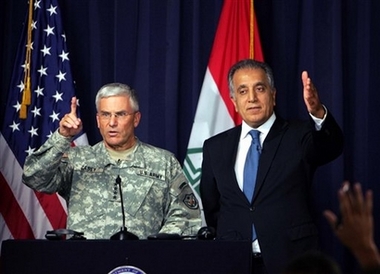BAGHDAD, Iraq - Two weeks before US midterm elections, American officials
unveiled a timeline Tuesday for Iraq's Shiite-led government to take specific
steps to calm the world's most dangerous capital and said more US troops might
be needed to quell the bloodshed.
US officials previously said they were satisfied with troop levels and had
expected to make significant reductions by year's end. But a surge in sectarian
killings, which welled up this past summer, forced them to reconsider.
|

Top US commander in Iraq, General George Casey,left, and US
Ambassador to Iraq Zalmay Khalilzad answer questions during a press
conference at the heavily fortified Green Zone in Baghdad, Tuesday Oct.
24, 2006. [AP]
|
At a rare joint news conference with the American ambassador, the top US
commander in Iraq, Gen. George Casey, said additional US troops could come from
inside or outside Iraq to "improve basic services for the population of
Baghdad."
"Now, do we need more troops to do that? Maybe. And, as I've said all along,
if we do, I will ask for the troops I need, both coalition and Iraqis," Casey
said. There are currently 144,000 US forces in Iraq.
The military has expressed disappointment over its two-month drive to cleanse
the capital of Sunni insurgents and Shiite militia fighters and death squads.
But the Americans also say that for the situation to improve, the Iraqi
government must make political concessions to minority Sunnis.
The timeline grew out of recent Washington meetings at which the Bush
administration sought to reshape its Iraq policy amid mounting US deaths and
declining domestic support for the 44-month-old war. The plan was made public a
day after White House press secretary Tony Snow said the US was adjusting its
Iraq strategy but would not issue any ultimatums.
U.S. officials revealed neither specific incentives for the Iraqis to
implement the plan nor penalties for their failure to do so. US Ambassador
Zalmay Khalilzad said Iraqi leaders had agreed to the timeline, benchmarks
heavily laden with enticements to Sunni insurgents.
The lack of any real political consensus even among Shiites, however, has
made it extremely difficult for Iraqi leaders to keep deadlines; for example,
they missed targeted dates on naming a government and in moving forward on
constitutional amendments. Moreover, Tuesday's declarations lacked specifics on
how to accomplish the goals.
At the news conference with Casey, Khalilzad said the timeline would require
Prime Minister Nouri al-Maliki's government to set dates by the end of the year
for completing six key tasks.
Five of the markers are clearly designed to mollify Sunni Arabs, the Muslim
sect that makes up the bulk of the insurgency and is responsible for most
American deaths in Iraq.
The plan seeks deadlines for passing a law that would guarantee the sharing
of Iraq's oil wealth, amending the constitution, turning an anti-Baathist
organization into a reconciliation body, disbanding Shiite militias and setting
a date for provincial elections - all key issues for Sunnis.
The de-Baathification Commission was established after the toppling of Saddam
Hussein to ensure that members of the dictator's political organization did not
hold government positions.
The sixth measure called for "increasing the credibility and capability of
Iraqi forces."
| 1 | 2 |  |